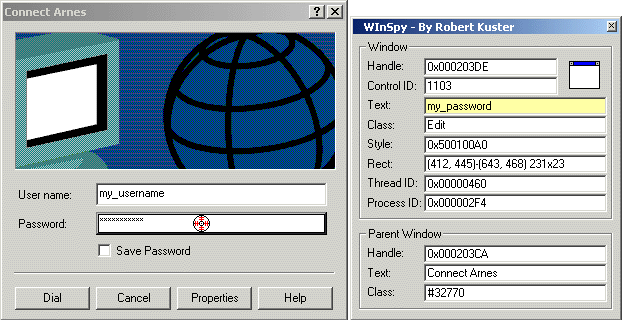Three Ways to Inject Your Code into Another Process
2008-11-08 10:08
525 查看
Download entire package - 180 Kb
Download WinSpy - 20 Kb (demo application)
Windows Hooks
The CreateRemoteThread & LoadLibrary TechniqueInterprocess Communications
The CreateRemoteThread & WriteProcessMemory TechniqueHow to Subclass a Remote Control With this Technique
When to Use this Technique
Some Final Words
Appendixes
References
Article History

Several password spy tutorials have been posted to The Code Project, but all of them rely on Windows hooks. Is there any other way to make such a utility? Yes, there is. But first, let me review the problem briefly, just to make sure we're all on the same page.To "read" the contents of any control - either belonging to your application or not - you generally send the

Collapse
Put your code into a DLL and map the DLL to the remote process using the CreateRemoteThread & LoadLibrary technique.
Instead of writing a separate DLL, copy your code to the remote process directly - via
for more information: http://www.codeproject.com/KB/threads/winspy.aspx?df=100&forumid=16291&select=1025152&msg=1025152
Download WinSpy - 20 Kb (demo application)
Contents
IntroductionWindows Hooks
The CreateRemoteThread & LoadLibrary TechniqueInterprocess Communications
The CreateRemoteThread & WriteProcessMemory TechniqueHow to Subclass a Remote Control With this Technique
When to Use this Technique
Some Final Words
Appendixes
References
Article History
Introduction

Several password spy tutorials have been posted to The Code Project, but all of them rely on Windows hooks. Is there any other way to make such a utility? Yes, there is. But first, let me review the problem briefly, just to make sure we're all on the same page.To "read" the contents of any control - either belonging to your application or not - you generally send the
WM_GETTEXTmessage to it. This also applies to edit controls, except in one special case. If the edit control belongs to another process and the
ES_PASSWORDstyle is set, this approach fails. Only the process that "owns" the password control can get its contents via
WM_GETTEXT. So, our problem reduces to the following: How to get

Collapse
::SendMessage( hPwdEdit, WM_GETTEXT, nMaxChars, psBuffer );executed in the address space of another process.In general, there are three possibilities to solve this problem:Put your code into a DLL; then, map the DLL to the remote process via windows hooks.
Put your code into a DLL and map the DLL to the remote process using the CreateRemoteThread & LoadLibrary technique.
Instead of writing a separate DLL, copy your code to the remote process directly - via
WriteProcessMemory- and start its execution with
CreateRemoteThread. A detailed description of this technique can be found here.
for more information: http://www.codeproject.com/KB/threads/winspy.aspx?df=100&forumid=16291&select=1025152&msg=1025152
相关文章推荐
- Three Ways To Inject Your Code Into Another Process
- Three Ways to Inject Your Code into Another Process
- 转帖:Three Ways to Inject Your Code into Another Process
- Three Ways to Inject Your Code into Another Process
- Three Ways to Inject Your Code into Another Process
- Three Ways to Inject Your Code into Another Process
- Three Ways to Inject Your Code into Another Process
- Three Ways to Inject Your Code into Another Process
- Three ways to get your MAC address
- Inject your code to a Portable Executable file
- Inject your code to a Portable Executable file by ashkbiz
- 10 ways to make your code more testable
- Your task is to find for a given phone number any of its divisions into groups of two or three digit
- Inject your code to a Portable Executable file
- jQuery Lint: enables you to automatically inject jQuery Lint into the page as it is loaded (great for ad-hoc code validation)
- Three ways to get your MAC address
- Inject Your Code to a Portable Executable File[www.codeguru.com]
- Inject your code to a Portable Executable file
- Three ways to throw exception in C#. Which is your preference?
- 代码注入(Inject your code to a Portable Executable file)
